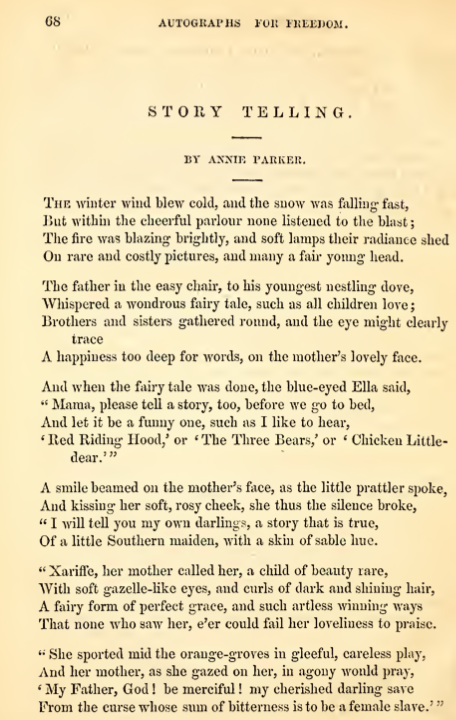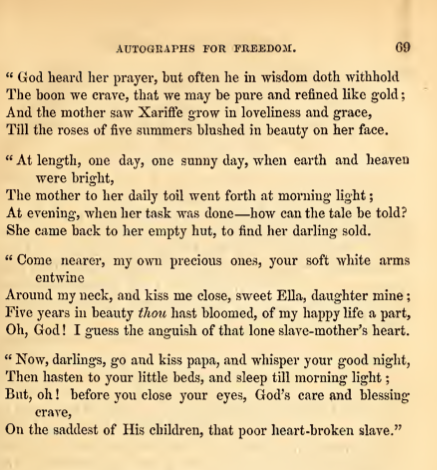This text is part of the Teaching Hard History Text Library and aligns with Key Concept 5.


STORY TELLING.
BY ANNIE PARKER.
The winter wind blew cold, and the snow was falling fast,
But within the cheerful parlour none listened to the blast;
The fire was blazing brightly, and soft lamps their radiance shed
On rare and costly pictures, and many a fair young head.
The father in the easy chair, to his youngest nestling dove,
Whispered a wondrous fairy tale, such as all children love;
Brothers and sisters gathered round, and the eye might clearly
trace
A happiness too deep for words, on the mother’s lovely face.
And when the fairy tale was done, the blue-eyed Ella said,
“Mama, please tell a story, too, before we go to bed,
And let it be a funny one, such as I like to hear,
‘Red Riding Hood,’ or ‘The Three Bears,’ or ‘Chicken Little-
Dear.’”
A smile beamed on the mother’s face, as the little prattler spoke,
And kissing her soft, rosy cheek, she thus the silence broke,
“I will tell you my own darlings, a story that is true,
Of a little Southern maiden, with a skin of sable hue.
“Xariffe, her mother called her, a child of beauty rare,
With soft gazelle-like eyes, and curls of dark and shining hair,
A fairy form of perfect grace, and such artless winning ways
That none who saw her, e’er could fail her loveliness to praise.
“She sported mid the orange-groves in gleeful, careless play,
And her mother, as she gazed on her, in agony would pray,
‘My Father, God! be merciful! my cherished darling save
From the curse whose sum of bitterness is to be a female slave.’”
“God heard her prayer, but often he in wisdom doth withhold
The boom we crave, that we may be pure and refined like gold;
And the mother saw Xariffe grow in loveliness and grace,
Till the roses of five summers blushed in beauty on her face.
“At length, one day, one sunny day, when earth and heaven
were bright,
The mother to her daily toil went forth at morning light;
At evening, when her task was done—how can the tale be told?
She came back to her empty hut, to find her darling sold.
“Come nearer, my own precious ones, your soft white arms
entwine
Around my neck, and kiss me close, sweet Ella, daughter mine;
Five years in beauty thou hast bloomed, of my happy life a part,
Oh, God! I guess the anguish of that lone slave-mother’s heart.
“Now, darlings, go and kiss papa, and whisper your good night,
Then hasten to your little beds, and sleep till morning light;
But, oh! before you close your eyes, God’s care and blessing
crave,
On the saddest of His children, that poor heart-broken slave.”